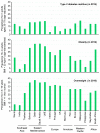The Role of Obesity in Type 2 Diabetes Mellitus-An Overview
- PMID: 38339160
- PMCID: PMC10855901
- DOI: 10.3390/ijms25031882
The Role of Obesity in Type 2 Diabetes Mellitus-An Overview
Abstract
Obesity or excessive weight gain is identified as the most important and significant risk factor in the development and progression of type 2 diabetes mellitus (DM) in all age groups. It has reached pandemic dimensions, making the treatment of obesity crucial in the prevention and management of type 2 DM worldwide. Multiple clinical studies have demonstrated that moderate and sustained weight loss can improve blood glucose levels, insulin action and reduce the need for diabetic medications. A combined approach of diet, exercise and lifestyle modifications can successfully reduce obesity and subsequently ameliorate the ill effects and deadly complications of DM. This approach also helps largely in the prevention, control and remission of DM. Obesity and DM are chronic diseases that are increasing globally, requiring new approaches to manage and prevent diabetes in obese individuals. Therefore, it is essential to understand the mechanistic link between the two and design a comprehensive approach to increase life expectancy and improve the quality of life in patients with type 2 DM and obesity. This literature review provides explicit information on the clinical definitions of obesity and type 2 DM, the incidence and prevalence of type 2 DM in obese individuals, the indispensable role of obesity in the pathophysiology of type 2 DM and their mechanistic link. It also discusses clinical studies and outlines the recent management approaches for the treatment of these associated conditions. Additionally, in vivo studies on obesity and type 2 DM are discussed here as they pave the way for more rigorous development of therapeutic approaches.
Keywords: clinical trials; in vivo studies; incidence; management; obesity; pathophysiology; prevalence; therapeutic approach; type 2 diabetes.
Conflict of interest statement
The authors declare no conflicts of interest.
Figures






References
-
- Expert Panel on the Identification, Evaluation, and Treatment of Overweight and Obesity in Adults (U.S.) Clinical Guidelines on the identification, evaluation, and treatment of overweight and obesity in adults—The evidence report. Obes. Res. 1998;6((Suppl. S2)):51S–209S. - PubMed
Publication types
MeSH terms
Grants and funding
LinkOut - more resources
Full Text Sources
Medical

